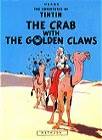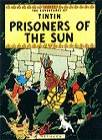 |

Previous books...
 |  |
 |
 The Crab with the Golden Claws
The Crab with the Golden Claws
Tintin finds a mysterious tin-can that leads him to look into a counterfeit money deal. During his investigation he is imprisoned on
board a ship named Karaboudjan. He finds out that the crew is involved in opium trade. He meets Captain Haddock who is a prisoner of alcoholism and of his Lieutenant Allan. Tintin and Haddock flee and end up in Morocco. That is where he unmasks the traffickers. Those finally get arrested and the Captain enters once and for all in the family of Tintin's adventures...
Belgium being occupied, Hergé had to make do with neutral subjects. He published this album in 1941 which was redone in color in 1943. Just like for Tintin in America, Hergé was forced by his American publishers to alter certain characters. Especially so on page 17 case A2, page 53 D2 . Also, the scenes where Haddock is drinking rum were modified not to show him drinking out of the bottle (page 19 BC and 25 A3-4) in order not to shock too much the young American mind...
Arabic: Tantan wa al-khalub að-ðahabiyyatu - Basque: Urrezko Hagindien Karramarroa - Bernese: Täntän u d Guldchrabbe - Brazilian: O Caranguejo das Tenazes de Ouro - Breton: Krank e veudoù aour - Bulgare: ? - Catalan: El cranc de les pinces d'or - Chinese: Hongqian pangxie jituande fumie - Czech: Krab se Zlatymi Klepety - Danish: Krabben med de gyldne kløer - Dutch: De krab met de gulden scharen - Esperanto: La krabo kun oraj pinĉiloj - Farsi: Kharchange Panje Tallayi - Finnish: Kultasaksinen rapu - French: Le Crabe aux pinces d'or - Friesian: De Krab mei de gouden skjirren - Galician: O caranguexo das tenaces de ouro - German: Die Krabbe mit den Goldenen Scheren - Greek: Ο
ΚΑΒΟΥΡΑΣ ΜΕ
ΤΙΣ ΧΡΥΣΕΣ
ΔΑΓΚΑΝΕΣ - Hebrew: Ha'sartan Im Tsvatot Ha'Zahav - Hungarian: Az Aranyollos Rak - Icelandic: Krabbinn med gyltu klærnar - Indonesian: Kepiting bercapit emas - Italian: Il granchio d'oro - Norwegian: Krabben med de gyldne klør - Polish: Krag o Zlotych Szczypavach - Portuguese: O Carangejo das Tenazes de Ouro - Romansch: Il giomberet cun las forschs d'aur - Russian: Краб с золотыми клешнями - Slovak: Krab So Zlatymi Klepetami - Spanish: El cangrejo de la pinzas de oro - Swedish: Krabban med guldklorna - Thai: ? - Turkish: Altin Kiskaçli Yengeç - Welsh: ?
|
|
|
 |
 |  |
 |
 Prisoners of the Sun
Prisoners of the Sun
This adventure is the sequel to The Seven Crystal Balls. Tintin and Haddock arrive in Peru, and find Calculus aboard the Pachacamac cargo liner, but the kidnappers succeed in bringing Calculus ashore. While following their traces, Tintin learns the existence of a mysterious Temple of the Sun, where the remaining Inca civilization lives. They go with Zorrino, a young Quechua Indian, to find Calculus. After having crossed the Andes and the jungle, they finally reach the temple. They learn that Calculus made a
sacrilege by wearing Rascar Capac's bracelet and that he will be sacrificed, just like them... Thanks to the plays of the chance and eclipses, the three companions are miraculously saved and leave the temple while promising never to reveal the existence of it...
This story was the first entirely published in the weekly Tintin. Hergé tested with it a new formatting à l'italienne (more or less a "landscape" orientation...), with the result that at the time the book was published, in 1949, some sequences had to be removed and some frames redrawn.
Afrikaans: ? - Arabic: Tantan fiy ma`bad ach-chams - Basque: Eguzkiaren tenplua - Brazilian: O Templo do Sol - Breton: Prizonidi an heol - Catalan: El temple del sol - Chinese: Taiyang shende qiutu - Danish: Soltemplet - Dutch: De Zonnetempel - Farsi: Maabade Khorsheed - Finnish: Auringon temppeli - French: Le Temple du soleil - Galician: O templo do sol - German: Der Sonnentempel - Greek: Ο
ΝΑΟΣ ΤΟΥ ΗΛΙΟΥ - Hebrew: Asirey Ha'shemesh - Icelandic: Fangarnir i Solhofinu - Indonesian: Tawanan dewa matahari - Italian: Il tempio del sole - Japanese: Taiyoh no Shinden - Malay: ? - Norwegian: Soltempelet - Occitan: Lo Temple del Solelh* - Portuguese: O Templo do Sol - Russian: Храм Солнца - Serbo-croat: Hram Sunca - Spanish: El templo del Sol - Swedish: Solens tempel - Turkish: Günes Mabedi
* Cité en bas de page mais non publié
|
|
|
 |
 |  |
 |
 Land of Black Gold
Land of Black Gold
The rumours of war are very strong as falsified gasoline invades the market. Tintin leaves to investigate in the Middle East. He lands in Khemed where there is a political fight between Emir Ben Kalish Ezab and Sheik Bab El Ehr, each one financed by a different oil company. Tintin meets again Doctor Müller, who has become an agent of Skoil, allied with Bab El Ehr. Müller kidnaps the emir's son, Abdallah, to force the emir to expel the Arabex company from the country. Tintin kills his plans and discovers on him the product which falsified the gasoline.
Land of Black Gold is a special book among the other adventures of Tintin. Normally, it should have followed King Ottokar's Sceptre, but the war (so the rumours where true!...) stopped Hergé's work as Le XXe siècle closed, and it is only in 1948 that he resumed the story. The first color version came out in 1950. In 1971, at the request of his English editor, Hergé modified some elements of the history that were too much close to the topicality of 1948. Thus, the fights between Jewish and Arab terrorists for the control of Palestine are transformed into a political fight, the English police officers are now Arab and Haïfa becomes a somewhat more discrete Khemikhal..
Basque: Tintin urre beltzaren lurraldean - Bengali: Kelo Sonar Deshi - Brazilian: Tintim no País do Ouro Negro - Breton: Tintin e Bro an aour du - Catalan: Tintín al país de l'or negre - Danish: Det sorte guld - Dutch: Kuifje en het zwarte goud - Farsi: Sarzameene Tallaye Siyah - Finnish: Mustan kullan maa - French: Au pays de l'or noir - Galician: Tintín no país do ouro negro - German: Im Reiche Des Schwarzen Goldes - Greek: ΣΤΗ
ΧΩΡΑ ΤΟΥ
ΜΑΥΡΟΥ ΧΡΥΣΟΥ - Hebrew: Eretz Ha'Zahav Ha'Shachor - Icelandic: Svartagull - Indonesian: Negeri emas hitam - Italian: Tintin nel paese dell'oro nero - Japanese: Moeru Mizu no Kuni - Norwegian: Det sorte gull - Portuguese: Tintim no País do Ouro Negro - Spanish: Tintín en el país del oro negro - Swedish: Det svarta guldet - Turkish: Kara Altin Diyarinda
|
|
|
 |

Next books...

 
|










